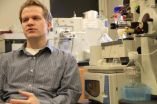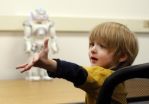(Press-News.org) In the early 1950's, a 66-year-old woman, sick with colon cancer, received a blood transfusion. Then, unexpectedly, she suffered a severe rejection of the transfused blood. Reporting on her case, the French medical journal Revue D'Hématologie identified her as, simply, "Patient Vel."
After a previous transfusion, it turns out, Mrs. Vel had developed a potent antibody against some unknown molecule found on the red blood cells of most people in the world—but not found on her own red blood cells.
But what was this molecule? Nobody could find it. A blood mystery began, and, from her case, a new blood type, "Vel-negative," was described in 1952.
Soon it was discovered that Mrs. Vel was not alone. Though rare, it is estimated now that over 200,000 people in Europe and a similar number in North America are Vel-negative, about 1 in 2,500.
For these people, successive blood transfusions could easily turn to kidney failure and death. So, for sixty years, doctors and researchers have hunted—unsuccessfully—for the underlying cause of this blood type.
But now a team of scientists from the University of Vermont and France has found the missing molecule—a tiny protein called SMIM1—and the mystery is solved.
Reporting in the journal EMBO Molecular Medicine, UVM's Bryan Ballif, Lionel Arnaud of the French National Institute of Blood Transfusion, and their colleagues explain how they uncovered the biochemical and genetic basis of Vel-negative blood.
"Our findings promise to provide immediate assistance to health-care professionals should they encounter this rare but vexing blood type," says Ballif.
The pre-publication results were presented online, March 18, 2013, and the finalized report will be published, as an open-access article, in the next edition of the journal.
(Last year, Ballif and Arnaud identified the proteins responsible for two other rare blood types, Junior and Langeris, moving the global count of understood blood types or systems from 30 to 32. Now, with Vel, the number rises to 33.)
Before this new research, the only way to determine if someone was Vel-negative or positive was with tests using antibodies made by the few people previously identified as Vel-negative following their rejection of transfused blood. Not surprisingly, these antibodies are vanishingly rare and, therefore, many hospitals and blood banks don't have the capacity to test for this blood type.
"Vel– blood is one of the most difficult blood types to supply in many countries," the scientists write, "This is partly due to the rarity of the Vel− blood type, but also to the lack of systematic screening for the Vel−type in blood donors."
In response, the UVM and Paris researchers developed two fast DNA-based tests for identifying Vel-negative blood and people. These tests can be easily integrated into existing blood testing procedures—and can be completed in a few hours or less.
"It's usually a crisis when you need a transfusion" says Ballif. "For those rare Vel-negative individuals in need of a blood transfusion, this is a potentially life-saving time frame."
To make their discovery, Arnaud and coworkers in Paris used some of the rare Vel-negative antibody to biochemically purify the mystery protein from the surface of human red blood cells. Then they shipped them to Ballif in Vermont.
The little protein didn't reveal its identity easily. "I had to fish through thousands of proteins," Ballif says. And several experiments failed to find the culprit because of its unusual biochemistry—and pipsqueak size. But he eventually nabbed it using a high-resolution mass spectrometer funded by the Vermont Genetics Network. And what he found was new to science. "It was only a predicted protein based on the human genome," says Ballif, but hadn't yet been observed. It has since been named: Small Integral Membrane Protein 1, or SMIM1.
Next, Arnaud's team in France tested seventy people known to be Vel-negative. In every case, they found a deletion—a tiny missing chunk of DNA—in the gene that instructs cells on how to manufacture SMIM1. This was the final proof the scientists needed to show that the Vel-negative blood type is caused by a lack of the SMIM1 protein on a patient's red blood cells.
Today, personalized medicine— where doctors treat us based on our unique biological makeup—is a hot trend. "The science of blood transfusion has been attempting personalized medicine since its inception," Ballif notes, "given that its goal is to personalize a transfusion by making the best match possible between donor and recipient."
"Identifying and making available rare blood types such as Vel-negative blood brings us closer to a goal of personalized medicine," he says. "Even if you are that rare one person out of 2,500 that is Vel-negative, we now know how to rapidly type your blood and find blood for you—should you need a transfusion."
INFORMATION:
Baffling blood problem explained
60-year-old health mystery solved by Vermont and French research team
2013-03-21
ELSE PRESS RELEASES FROM THIS DATE:
Media coverage of mass shootings contributes to negative attitudes towards mental illness
2013-03-21
News stories about mass shootings involving a shooter with mental illness heighten readers' negative attitudes toward persons with serious mental illness, according to a new report by the Johns Hopkins Bloomberg School of Public Health. The researchers also examined how such news stories impact support for policies to reduce gun violence. Compared to study respondents who did not read a story about a mass shooting, reading a news article describing a mass shooting raised readers' support for both gun restrictions for persons with serious mental illness, and for a ban on ...
Teen mentors inspire healthier choices in younger children
2013-03-21
COLUMBUS, Ohio – An obesity intervention taught by teen mentors in Appalachian elementary schools resulted in weight loss, lower blood pressure and healthy lifestyle changes among the younger students learning the curriculum, according to a new study.
In contrast, children taught the same lessons by adults in a traditional classroom saw no changes in their health outcomes.
The results of the eight-week clinical trial conducted by Ohio State University researchers suggest that school systems could consider using teen mentors to instruct younger children in select health-related ...
Charges for emergency room visits often based on incorrect assumptions
2013-03-21
Visits to the ER are not always for true medical emergencies – and some policymakers have been fighting the problem by denying or limiting payments if the patient's diagnosis upon discharge is for "nonemergency" conditions.
Now a new UC San Francisco study challenges that framework by showing that criteria used as a basis to determine the appropriateness of an emergency room visit and to deny payment is inherently flawed. The study analyzed nearly 35,000 visits to hospital emergency departments around the country.
The research is published online today in JAMA (Journal ...
NIH-supported researchers identify new class of malaria compounds
2013-03-21
A group of researchers from 16 institutions around the world has identified a new class of anti-malarial compounds that target multiple stages of the malaria parasite's life cycle (http://www.niaid.nih.gov/topics/malaria/pages/lifecycle.aspx). These compounds could potentially be developed into drugs that treat and prevent malaria infection. Known as 4-(1H)-quinolone-3-diarylethers, the candidate anti-malarials are derived from a compound called endochin that effectively treats malaria in birds. When tested in the laboratory and in mice, the compounds demonstrated strong ...
Brain mapping reveals neurological basis of decision-making in rats
2013-03-21
Scientists at UC San Francisco have discovered how memory recall is linked to decision-making in rats, showing that measurable activity in one part of the brain occurs when rats in a maze are playing out memories that help them decide which way to turn. The more they play out these memories, the more likely they are to find their way correctly to the end of the maze.
In their study, reported this week in the journal Neuron, the UCSF researchers implanted electrodes directly on a region of the rat brain known as the hippocampus, which is already known to play a key role ...
New imaging agent enables better cancer detection, more accurate staging
2013-03-21
Researchers at the University of California, San Diego School of Medicine have shown that a new imaging dye, designed and developed at UC San Diego Moores Cancer Center, is an effective agent in detecting and mapping cancers that have reached the lymph nodes. The radioactive dye called Technetium Tc-99m tilmanocept, successfully identified cancerous lymph nodes and did a better job of marking cancers than the current standard dye. Results of the Phase III clinical trial published online today in the Annals of Surgical Oncology.
"Tilmanocept is a novel engineered radiopharmaceutical ...
Natural climate swings contribute more to increased monsoon rainfall than global warming
2013-03-21
Monsoon rainfall in the Northern Hemisphere impacts about 60% of the World population in Southeast Asia, West Africa and North America. Given the possible impacts of global warming, solid predictions of monsoon rainfall for the next decades are important for infrastructure planning and sustainable economic development. Such predictions, however, are very complex because they require not only pinning down how manmade greenhouse gas emissions will impact the monsoons and monsoon rainfall, but also a knowledge of natural long-term climate swings, about which little is known ...
Humanoid robot helps train children with autism
2013-03-21
"Aiden, look!" piped NAO, a two-foot tall humanoid robot, as it pointed to a flat-panel display on a far wall. As the cartoon dog Scooby Doo flashed on the screen, Aiden, a young boy with an unruly thatch of straw-colored hair, looked in the direction the robot was pointing.
Aiden, who is three-and-a-half years old, has been diagnosed with autism spectrum disorder (ASD). NAO (pronounced "now") is the diminutive "front man" for an elaborate system of cameras, sensors and computers designed specifically to help children like Aiden learn how to coordinate their attention ...
Optimal ESR and CRP cut-off values based on new criteria for periprosthetic joint infection
2013-03-21
(CHICAGO) – Infections, as the news has shown time and again, can be deadly. Periprothesthetic joint infection (PJI) is the infection of grave concern to the orthopedic community, especially in its growingly common antibiotic-resistant form. This all-too-common infection can be found deep inside the joint prosthesis following joint replacement surgery.
Javad Parvizi, MD, and colleagues at the Rothman Institute at Jefferson have worked for years to find a solution to this sometimes deadly infection. Their most recent work has attempted to determine the optimal thresholds ...
Platelet-rich plasma significantly improves outcomes in patients with tennis elbow
2013-03-21
(CHICAGO) – Platelet rich plasma (PRP) therapy has been used to manage pain associated with torn tendons, muscles and ligaments, mostly in athletes, at all levels. Though it has anecdotally been successful, the evidence to support its efficaciousness is weak. Researchers at the Rothman Institute at Jefferson participated in a multi-center randomized prospective study to evaluate the clinical value of PRP versus an active control group to determine its effectiveness in managing the pain and tenderness associated with tennis elbow.
The results will be presented on Thursday, ...
LAST 30 PRESS RELEASES:
New fossil study illuminates on the evolutionary success of frogs
Patient-specific human liver model to understand disease mechanisms
Confused by the doctor's questionnaire? U of A study suggests it's common
How do brains stay stable, and when might a dose of flexibility be helpful?
mRNA revitalizes aging immune systems—the liver as a fountain of youth
Rural-urban differences in the prevalence of chronic pain among adult cancer survivors
Food insecurity, burnout, and social isolation among resident and fellow physicians
How do spinal cord injuries heal?
Detailed cell map unlocks secrets of how reproductive organs form
Large language models unleash AI’s potential for autonomous and explainable materials discovery
Gut bacteria have evolved rapidly to digest starches in ultra-processed foods
New risk score helps predict pancreatic cancer recurrence
New evidence challenges understanding of Parkinson’s disease
A new study reveals how embryos and the uterus “talk” during implantation
Cedars-Sinai reports heart attacks, general illness spiked after LA fires
PolyU develops ultra-stable, mucus-inspired hydrogel to boost gastrointestinal wound healing
Flour choice shapes sourdough microbial communities
Can a retinal implant reverse macular degeneration?
Feeding fungi plant remnants produces tasty protein to fortify vegan, vegetarian diets
New tech reduces false positives from breast ultrasounds
Drone-mounted lab monitors fertilizer runoff in real time
Short, light-intensity exercise boosts executive function and elevates mood in children
Jeonbuk National University researchers reveal new interface engineering strategy for efficient and stable back-contact solar cells
Tyrosinase drives hydroquinone-induced exogenous ochronosis: not HGD inhibition
UMass Amherst chemists develop unique tool for studying RNA
Disappointment alters brain chemistry and behavior
A built-in odometer: new study reveals how the brain measures distance
Stress-related brain signals drive risk of cardiovascular disease in people with depression and anxiety
New details on role of fat transport molecules in Alzheimer’s onset
Study illuminates how an antiviral defense mechanism may lead to Alzheimer’s disease
[Press-News.org] Baffling blood problem explained60-year-old health mystery solved by Vermont and French research team






